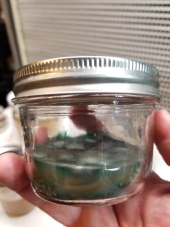Dustin Rhodes wrote:
criteria:
- Shelf-stable, long lasting in the can(or alive/regenerative);
- no VOC or other toxic chemicals;
- can't decrease the integrity of the wood(if used correctly);
- can be used on ANY wood species;
It's alive. Unknown storage characteristics, lasts at least 3 months unopened.
No toxic chemicals, I've eaten it. (Working with spalted wood, the finished product, poses its own unique risks for immuno-compromised individuals. Basically use breathing filters around wood dust.)
Spalting is wood rot, that naturally decreases structural integrity of wood, which is somewhat controllable by timing the length of the spalting process - spalted wood should not be used as a load-bearing material.
There are multiple spalting fungi for every wood species.
Dustin Rhodes wrote:I'd be willing to pay a fair bit for it
Well, two bits is $.50 where I'm from... Are you sure you wouldn't go any higher?












